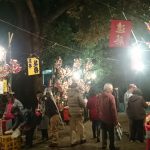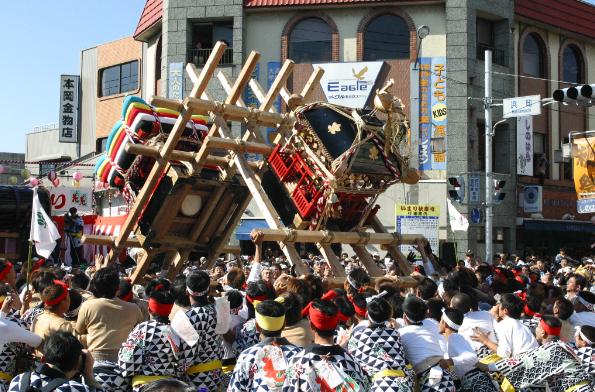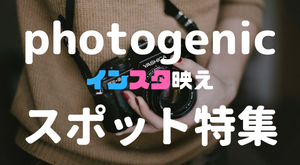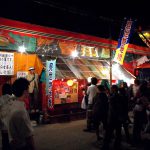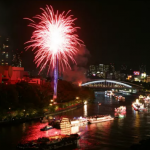Misemono-Goya by Otora Kogyo Company (October 2008) – Photo by Mr. Kounosu (details at the bottom)
Note: This column focuses only on modern shows from the Meiji era onwards.
Do you know what a “misemono-goya” is? Generally, a misemono-goya is a type of entertainment typically held at festivals, designed to evoke feelings of “wonder” or “horror” through various contrivances. Sometimes, it might include content that is vulgar or grotesque, giving it a reputation as a frightening place.
In recent times, due to social changes, these shows have largely disappeared because they are seen as “noisy,” “shady,” or “lacking in morals and ethics.”
Despite this decline, I have a certain admiration for Japanese misemono-goya. There’s something about the combination of the “thrill of fear” and the “atmosphere of Japanese tradition” that captivates me in a way that is different from a traditional haunted house.
So, in this piece, I want to talk about why “misemono-goya are kind of cool,” from the perspective of someone in their 20s.
Preface: Why Are We Drawn to Misemono-Goya?
Why are we drawn to misemono-goya? From my personal perspective, as I mentioned earlier, it’s the “thrill of fear” combined with the “taste of Japanese tradition.” But let’s delve a little deeper.
In reality, the answer to this question might differ between now and the past. When misemono-goya first started as a form of entertainment and were held at many venues where people gathered, they were no different from modern-day circuses or street performances.
When something is commonplace, people are interested only in the essence of that thing itself, so they visit misemono-goya with the desire to be “surprised” or to “see something strange.”
But it’s different today. In addition to this basic appeal, there’s a “stronger thrill of fear” attached to it. Strictly speaking, the reason for visiting misemono-goya in the past likely included this thrill of fear, but today it is “much stronger.”
The source of this thrill is the rarity of these shows and the specialty of knowing about them only through fiction. These factors make the “image of misemono-goya” from the past more attractive.
Additionally, the unique atmosphere of traditional festivals and shows in misemono-goya—specifically the distinctive Asian aesthetic that comes from the involvement of outlaws and outsiders—enhances their appeal.
In recent years, more artists have begun to view and express the “weirdness” and “thrill of fear” associated with misemono-goya as avant-garde works, indicating that they are gaining support from the younger generation.
Second Act: What Kind of Shows Were There in Misemono-Goya?
Before considering the future of misemono-goya in Japan, we should think about what these shows were like.
I heard that misemono-goya are still prevalent in Southeast Asia and China today, so I looked up some literature on the subject.
In “Modern Popular Life History 17: Misemono and Festivals” by Minami Hiroshi (Sanichi Shobo, 1994), there is a recollection by actor and entertainment researcher Shoichi Ozawa, who also served as an advisor for the Misemono Society, about his visit to the Chinese New Year festival in Tianqiao in the 1980s.
Ideally, I would like to quote Ozawa’s words directly, as his unique style is a charm of the book. However, to maintain the purpose of this article, I will summarize his account.
The Chinese New Year is similar to Japan’s New Year, but China still retains a unique atmosphere reminiscent of Japan’s Showa era. There is incredible vibrancy and many misemono that you rarely see in Japan nowadays.
Alongside food stalls selling strange food, there are garish neon-lit entrances to misemono-goya. The themes are similar to those of old Japan: “snake woman,” “rokurokubi” (a woman whose neck stretches), “two-headed beauty,” “spider woman,” and so on. The posters are often misleading and grotesque.
An older man would stand there energetically drawing in customers while holding a sign featuring a woman with her large chest prominently displayed.
Curious, when I entered one of these misemono-goya, there was an older man in flashy clothes performing something like Qigong. As I watched, a beautiful woman in flamboyant attire would occasionally carry a pot, teasing the audience into thinking she might perform next.
This account by Ozawa gives a glimpse into his excitement.
From this, it seems like many of these shows featured attractive women in revealing and flashy costumes. This was likely common in Japanese misemono as well. Although there is a strong association with employing people with disabilities, it appears that some aspects were closer to the sex industry. However, the approach was entirely different, which is part of their unique charm in modern Japan.
The inexplicable nature of these shows might be the essence of misemono-goya’s appeal.
Main Act: Modern-Day Misemono-Goya in Japan
Misemono-goya can still be found in Japan today, particularly at festivals and Tori-no-Ichi markets in cities like Tokyo.
However, as of 2018, they are increasingly rare. In the early 2010s, they were still relatively active, and you could find many blog posts about them. There are also many people who have shared their experiences with modern misemono-goya with photos, but I couldn’t get permission to use them for this article.
A notable group operating misemono-goya today is the “Gokiburi Kombinat” (Cockroach Combine) theater troupe.
Their official website might be a bit intimidating, but the shows retain the essential “eeriness” and “mysteriousness” necessary for misemono performances.
Personally, I have a great fondness for “Koyuki Dofu,” who performed in the snake-eating woman act. Her seductive atmosphere and poise, along with the act of sipping snake blood, create an inexplicable feeling (not in a weird way).
Conclusion: The Existence of Misemono-Goya
That concludes our discussion on misemono-goya.
In our modern age, where science has advanced to the point where it is hard to distinguish from science fiction, public entertainment has become diverse, and the underground world of festivals, including erotic and grotesque elements, is being hidden away.
While I’m not advocating for a particular stance, I do feel a twinge of sadness about the current trend to shun dangerous forms of entertainment.
If you’re even slightly interested, I encourage you to find a festival that features a misemono-goya and visit it. And I hope you will share the experience with friends or anyone else.
“Have you ever been to a misemono-goya? It’s wild!”
About the Featured Image
The image is referenced from this link. It follows the terms of CC Attribution-ShareAlike 3.0. Please check the link for more details on redistribution and modifications.



